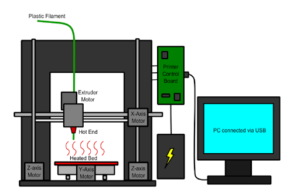We have carried out the development and the associated manufacturing of 3-D printing for various components and applications. Over years our efforts also include the following two projects using 3D printing technology:
1. Cost-effective, Scalable 3D Printed Phased Arrays
Bioenno Tech has carried out the development of affordable 3D Printed Phased Arrays. The potential promise of using a 3D printing process to manufacture a phased array antenna are expected to dramatically reduce cost and simultaneously enhance the mechanical, electrical and radio frequency (RF) performance. At present the ink-jet printed techniques have been used to produce 2-dimentional antenna structures applicable for conformal surfaces and notably supporting the radio frequency identification (RFID) revolution. Through high-precision multi-layer dense integration, 3D printing offers the ability to form novel interconnections, packaging, and embedded circuits supporting phase shifters, delay lines, filters and shaped RF characteristics. The intent of this development is to build a multifunction 3D layer composed of low power functions such as phase shifting or true time delay, gain control, switching, low power amplification, filtering, interconnectivity, thermal management, and mechanical packaging. The successful development of 3-D printing RF devices directly benefits commercial wireless industry, and benefits other industries as well including micro-controllers, robotics, healthcare, smart devices, and vehicles.
A new generation of 3D printing including additive manufacturing (AM) techniques is expanding the possibilities of sensor and antenna design, with important implications for the performance and cost of finished devices. 3D printed phased array antennas (PAA) is expected to more rugged, lighter and take a variety of shapes and including unmanned aerial vehicle (UAV) wings. Our development effort starts with trade studies identifying the best printing technique or combination of techniques to meet the targeted phased array performance goals. The printed array, which offers dual polarization, will incorporate both printed radiating elements and a novel printed packaging concept for the array electronics, by employing an innovative combination of well-proved approach that will minimize production costs, array volume, and thermal management issues, and maximize array efficiency. Over recent years, printing antennas, passives and interconnects and printing field effect transistors (FET) including printing switches in the GHz regime have been demonstrated in 3D printing. This proposed effort will utilize micro-dispensing, also known as direct printing, to print the entire PAA. This effort will leverage our experience with printed electronics, phased array antenna design, and phased array antenna fabrication and testing. Phase I program will focus on the design, fabrication, and cost of a single printed array element, delivering a path to show the cost savings and the feasibility of printing a full PAA in Phase II. The Phase II efforts will focus on larger, steerable printed arrays, whose design and fabrication will be informed by the Phase I study, and accelerate development of printed, high-efficiency phased arrays directed toward the potential applications.
2. Additive Manufacturing (3-D Printing) of Affordable Solid Oxide Fuel Cell (SOFC)
Advanced manufacturing based on 3-D printing, also referred to as Additive manufacturing (AM), is emerging as an especially potent driver of future economic growth, which can be used to improve existing manufacturing processes and rapidly introduce new prototypes and products. This class of paradigm-shifting manufacturing technology offers the potential to spin off entirely new industries and lead to an attractive class of production methods that are most likely to remain in the United States as they are difficult to imitate in developing countries. One promising application of additive manufacturing (AM) is used to fabricate components in a layering manner and thus to produce net-shape products even with intricate configurations, for instance, energy devices. Over recent years, AM has been identified as a potentially attractive option for the cost-effective manufacture of high temperature performance components used in SOFC technology. The AM-based method will be able to address the demanding need for components processing that not only maintains structural integrity but also offers the ability to perform multiple functions as well, by enabling the design and synthesis of materials whose microstructure and the resultant properties allow for the construction of such components.
Bioenno Tech has carried out research and development that uses AM techniques to fabricate a complete SOFC cell that consists of electrolyte, anode and cathode. Each component in SOFC and the resultant complete SOFC cell will display the functionality and characteristics with potential to be equivalent or even exceed the performance requirements of current state of the art SOFC components. In this research, we show a clear plan that outlines how individual cell component and the entire SOFC cell architectures would be fabricated and implemented, and discuss performance attributes anticipated. We also present a complete description of the manufacturing process required to achieve the proposed architectures, which can be used to facilitate analysis of potential cost issues and implementation complexity. In Phase I, we will leverage our previous experience and demonstrate a simplified SOFC cells and a path to show the cost savings and the feasibility of printing a full complete SOFC in Phase II. We will characterize materials and processes compatible with the state-of-the-art SOFC design, model the performance and thermal response of the overall system, and establish a manufacturing plan with a low final cost per element. As part of the Phase I option, we will utilize AM technologies to produce novel interconnects and packaging schemes. Advances in the 3D printing of SOFC would immediately benefit existing SOFC industry and would even revolutionize the way the new-generation SOFC are conceived and fabricated.
